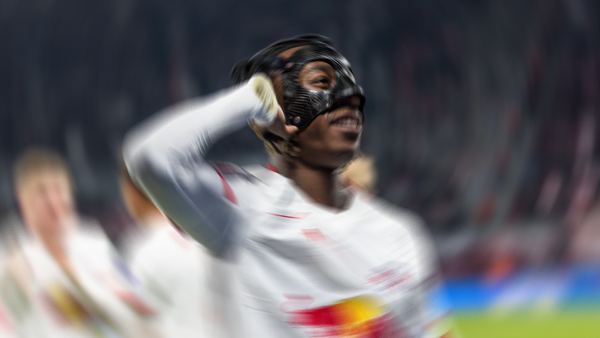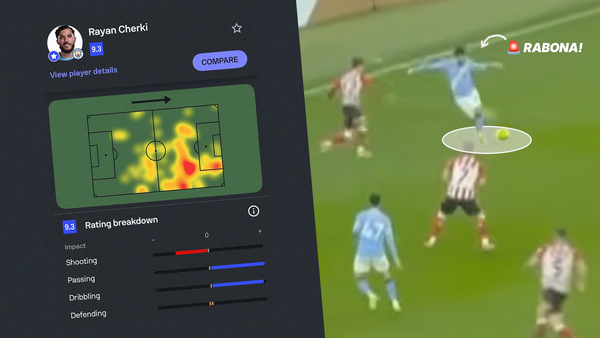Introducing: The Developer, our first midfield Archetype
...and why J.LEAGUE is the best place to spot them
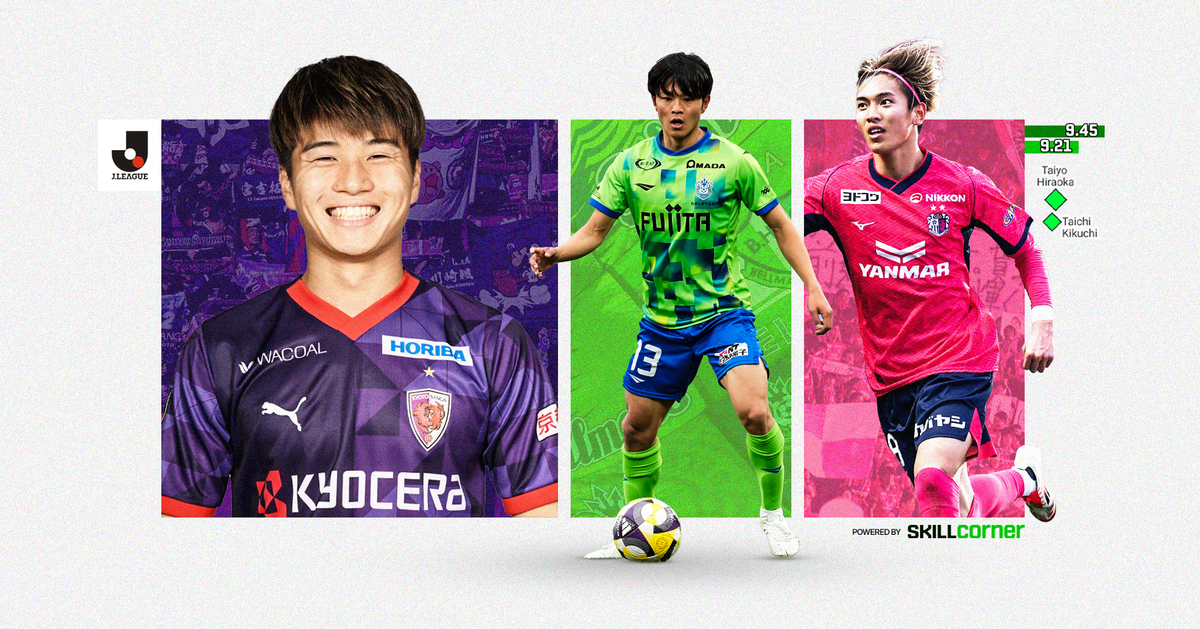
The Technical Area is back. A new edition of our behind-the-scenes editor's blog is available to read now. It includes detailed responses to the feedback we gathered from our recent survey (thanks to everyone who responded!), and plots our route ahead. Check it out:
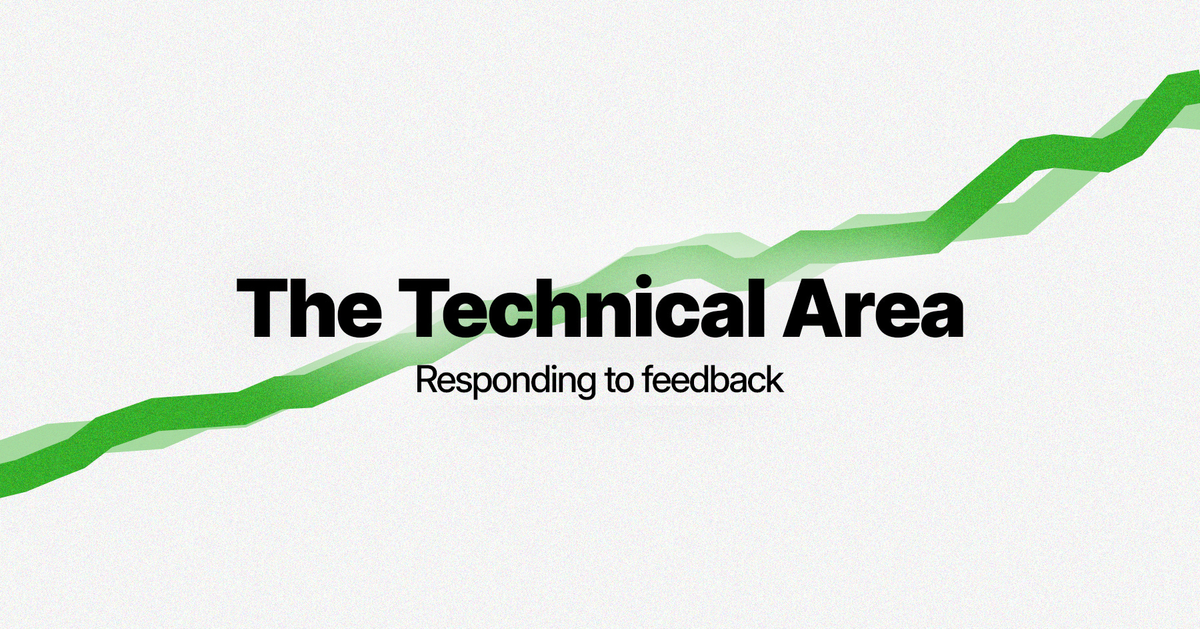
Midfielders who progress possession are extremely valuable. As is always the way with football, those midfielders come in different forms. You’ve got passers like Adam Wharton and carriers like Declan Rice, but what about the movers? Those midfielders who aid progression primarily by making smart runs and drifting into space? You don’t hear so much about the movers.
That’s why we’ve made them the foundation of our first midfield SCOUTED Archetype: the Developer.
These are the players tasked with advancing play and turning build-up sequences into promising attacking moves. Developers turn the screw, finding ways to move situations on by getting in behind defensive lines and sliding into advantageous positions.
What is a Developer?
The Developer was born from months of watching Sverre Halseth Nypan. He’s pretty niche to be a Poster Boy, I know – admittedly, he won’t be niche for long – but he featured prominently in my Secrets of Scandinavia analysis earlier this year, primarily for his ability to develop play. I wrote the following:
“A 90th percentile ranking for Runs Ahead of the Ball is particularly interesting because it leans into my pigeon-holing of Nypan as a ‘developing midfielder’. The Norwegian comes alive in the second phase of possession by sliding around to move sequences on: creating angles, finding one-twos, unselfish runs are the order of the day as he creates time and space for himself and others.”

That is the simplest manifestation of the Developer Archetype. Watch some clips of Nypan and you’ll see a midfielder that helps his team develop possession from the build-up phase to the attacking phase. He is a conduit through which they progress into promising areas. Sometimes he doesn’t even need to touch the ball to do it – a clever little run is enough to manipulate space for team-mates to benefit.
If Nypan is too niche, let’s consider some Premier League examples of Developers from the 2023/24 season.
A name I had in my head before even considering the data was Morgan Gibbs-White at Nottingham Forest. He fits the bill for being a midfielder that develops play in the second phases, getting on the ball between lines and penetrating them himself as a playmaker. It’s validating, then, that he shows up prominently on the Developer Runs.
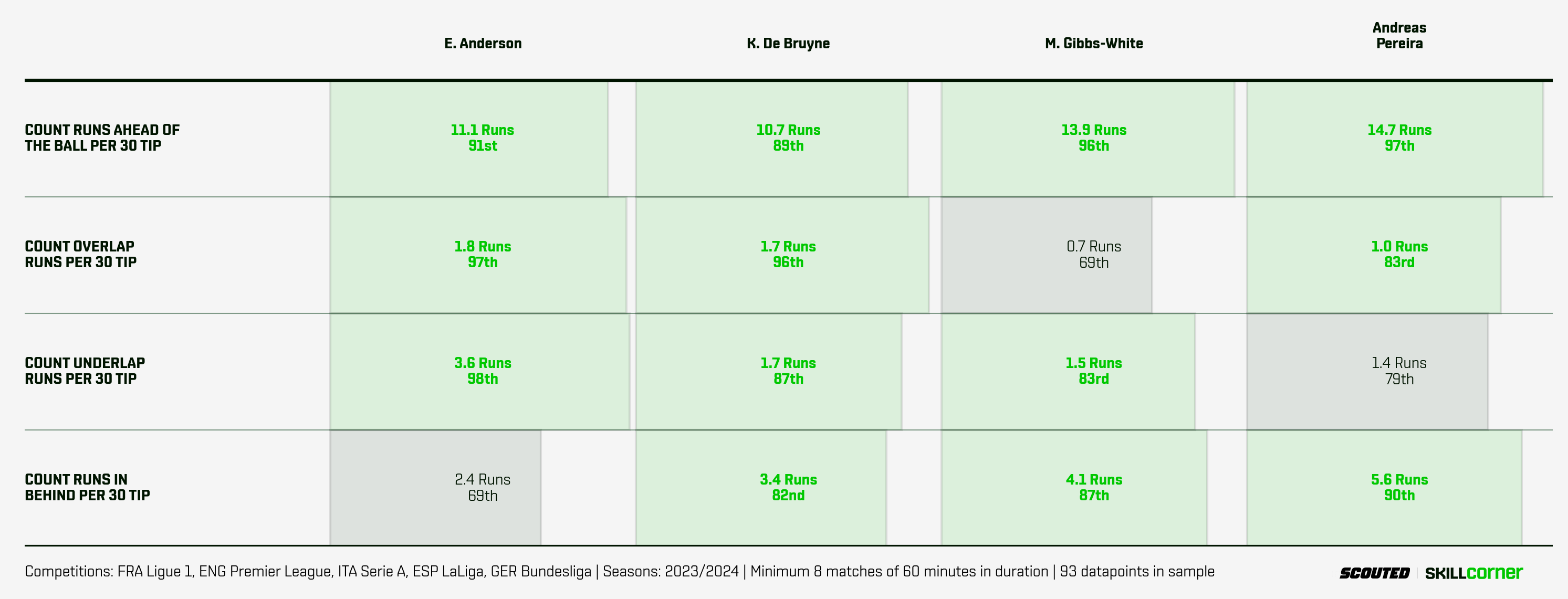
Kevin De Bruyne being there should be no surprise either, given his role at Manchester City. Fulham’s Andreas Pereira is another whose style fits the Developer tag, while Elliot Anderson – another from Forest – would be a very interesting case study to see how his data profile has shifted from last season to the current campaign.
Before we embark, some caveats. Football is complex – there are a lot of moving parts to the game that make its quantifying elements like this difficult. An endless amount of variables inevitably influence results. Tactics, for instance: some styles of play will be conducive to Developers, others won’t, and those styles are impacted by a range of ever-shifting factors that play against each other.
Which SkillCorner metrics define an Developer?
This is where the value of SkillCorner’s Game Intelligence data comes to the fore. The key pillar of an Developer’s output is their movement, meaning it would be practically impossible to quantify what they do using simple event data. But SkillCorner’s tracking data provides a whole new layer of depth to our analysis.
With that in mind, much of this analysis will centre Off-Ball Runs data, with three types of runs in particular being especially important. These are what we’re calling the Developer Runs:
- Runs Ahead of the Ball
- Overlapping/Underlapping Runs
- Runs In Behind
Runs Ahead of the Ball is the single most important metric when identifying an Developer. If a midfielder makes a lot of them, they are looking to develop play. These are the runs beyond play that enable teams to move up the pitch, getting in behind opposition lines, giving passers options to play forward, and move defensive structures around.
Overlapping/Underlapping Runs – or Lapping Runs for short – hold similar value in their ability to create options ahead of the ball, while Runs In Behind are synonymous with forwards but also carry value for Developers.
Which markets might hide undiscovered Developers?
Now we know what Developers are, the question becomes: how do we find the next generation?
The J.LEAGUE is becoming an ever more popular market for buying European clubs with each passing year. Japan is one of increasingly few markets that offers top-level talent at affordable prices with the attributes to make an immediate impact. The key contributing factor to that readiness is the intense physical demands of the league, which compares favourably to the best competitions in the world.

As the J.LEAGUE ranks above the average top-flight European league for its physical intensity, including the likes of Ligue 1 and LaLiga, it means its exports are generally capable of sticking the jump to Europe. Factor in the generally high technical and tactical standards of the league and you’re onto a winner.
Another reason is because J.LEAGUE midfielders make more Developer Runs than their peers in other notable Asian leagues, making it the obvious option to find talent of the Archetype.

To find some Developers from the J.LEAGUE, there’s only one place to start: Runs Ahead of the Ball.

Three players jump off the screen: Nagoya Grampus’ Taichi Kikuchi and Taiyo Hiraoka of Shonan Bellmare first and foremost, who are in a league of their own, as well as long-time SCOUTED favourite, Kuryu Matsuki. All three put up extraordinary numbers for Runs Ahead of the Ball in the 2024 J.LEAGUE season.
Matsuki left halfway through to join Southampton and subsequently be loaned out to Göztepe, but Kikuchi and Hiraoka stuck around and are regulars for their respective clubs in the recently-commenced 2025 season. There is some sample size effect with Kikuchi given he only played 527 minutes all in, but there are no such caveats with Hiraoka.
The 22-year-old played 1,739 minutes across 26 appearances for Shonan Bellmare in total, and it was only a two-month lay-off with an adductor injury that stopped him from playing a thousand more. He is the standout when it comes to Developer Runs in the J.LEAGUE, putting up monster numbers in all four Developer metrics.

He makes more Developer Runs than practically everyone and receives relative to frequency more than most too. The below-average serve ratio for the Lapping Runs could be unselfish runs that occupy defenders and create space for team-mates, which is a desired outcome of making such runs.

If we drill down on searching for Developers born in 2000 or later, the midfield landscape reveals its various roles. It presents a mix of those that play behind and ahead of the ball, as well as some that do a bit of both.
Hiraoka lights the screen up again, obviously, but a couple of others come to the fore as eye-catching Developers.

Sota Kawasaki is one. He is the most similar to the league-leading Hiraoka across the board, ranking in the 75th percentile or above for three of the four Developer metrics. He excels at running behind the defensive line relative to his position group and is a frequent mover ahead of the ball, making angles to receive passes. It tallies with what I’ve seen of Kawasaki before, as I highlighted in our Next Gen J.LEAGUE feature early last year:
“Kawasaki is a hive of activity in midfield. Energetic, persistent, relentless - all of those words are applicable to the small-but-mighty Kyoto Sanga captain. He’s all-action, all-energy on both sides of the ball: when his teams have it, he’s always making angles to receive the next pass. The best way to utilise his infectious energy is to let him expend it all over the pitch, popping up wherever he’s needed most.”
That closing sentence underlines a key tenet of the Developer. As well as progressing play, the best Developers add energy and impetus to sequences. Kawasaki does that with a non-stop style as obvious in the data as it is on the pitch.
Another to note is Ryotaro Araki. He burst onto the scene with a breakout season in 2021 as a 19-year-old at Kashima Antlers but struggled to maintain momentum in the following campaigns. A loan to FC Tokyo last year reinvigorated his career at a crucial juncture with the now-23-year-old impressing as an attacking force. He made lots of Developer Runs behind defensive lines, generally playing off the left to angle in on his strong right foot.
Araki and Hiraoka are two of the most threatening Developers as well: their Ahead of the Ball Runs contributed to more shots for their teams per 30 TIP than all but two others in the J.LEAGUE last season.

If we dig deeper on the J.LEAGUE midfielders that make Runs In Behind, we start to see the landscape stagger somewhat. Shintaro Nago made a load of them for Kashima Antlers, as did 27-year-old Mutsuki Kato and 25-year-old Masaki Ikeda.
Kato is worth a mention. He contributed to over 20 goals last season as one of the supporting attackers behind a focal point centre-forward for Sanfrecce Hiroshima in his best senior campaign to date. It may be a stretch to call him a midfielder, but he still operates in the spaces and ways that Developers do. At 27 years old, his window for a European move is narrowing but remains a legitimate option.

It is important to remember that team style and tactics will have an effect on these metrics.
Take Ikeda and Hiraoka as examples: they play for Shonan Bellmare who typically employ a 3-5-2 shape that provides its eights the safety of three centre-backs and a holding midfielder behind them. The Hiratsuka-based side are also renowned for an expansive, possession-oriented approach that will afford more opportunities to make Developer Runs as well.
Is there a correlation between Developers and athleticism?
One of the most interesting and invaluable features of SkillCorner data is pairing the Game Intelligence data with the Physical data. The ability to do that will be a pillar of our Archetype analysis, as we attempt to discover which athletic traits are most important for certain positions and roles.
With that in mind, is there a correlation between Developers in the J.LEAGUE and specific athletic outputs? The quick answer is yes.
There is a clear correlation between the frequency of Runs Ahead of the Ball and High Intensity Runs.

Drilling down further, SkillCorner data shows that the most frequent Developers are also among the most explosive midfielders in the league.

Both make sense when you consider the Archetype of a Developer. They tend to play between or behind lines, meaning the intensity, sharpness and repetition of their movement is amplified. They need to be quick to create passing angles, to find one-twos, to get on the overlap, to play on the half-turn and drive at defences. These are actions that require a certain level of speed and intensity to be most effective.
It would be interesting to explore these athletic correlations further, particularly looking at how these physical traits may (or may not) alter across different leagues and the individual standouts within them. That is an adventure for another time.
One particular J.LEAGUE player I am really excited for in this Archetype is Sota Kitano. He embodies a Developer every time I watch him – he slides around in the second phases, creating angles behind and between lines to receive passes, then furthering play into the final third and the attacking area in a mutlitude of attacking ways.
I expect the bits I've seen on the pitch to show up in top-end Developer data, but I'll come back to it when we have a larger sample size for the 2025 season.
The final word
This serves both as a brief introduction to The Developer, and as a glaring signpost: the J.LEAGUE is a great place to begin searching for this Archetype’s next generation.
But as with all our efforts in the Archetype project, the work continues. We’ll go further into this Archetype in the months ahead: rounding out the Developer’s data profile, fleshing out their on-pitch role in tactics and teambuilding, and building synergies between other Archetypes.
Stay tuned. For more on Archetypes, read our Introduction to Power Forwards - or our new collection of Full-Back Archetypes.


This newsletter was produced under a commercial collaboration with SkillCorner, SCOUTED’s official data partners. Their tracking and performance data is used by more than 150 of the world’s biggest clubs, leagues and confederations.







